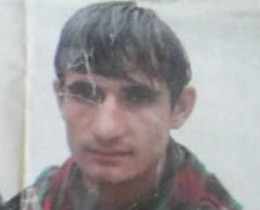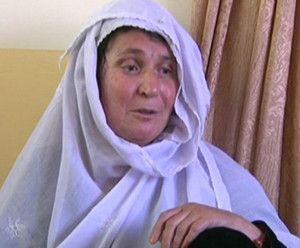By Ali M Latifi & Abdullah Shahood
In what had become a daily ritual, Anisa Shahghasi said goodbye to her son, Nawab, with prayers on her lips and a quick wave of her hand.
The world outside their cramped Kabul home was fraught with dangers. And like every other mother in the Afghan capital - which still witnesses regular bombings and deadly attacks - Anisa wished for her son’s safe return.

Nawab Shahghasi was killed in a suicide blast outside the ISAF headquarters in Kabul. Anisa, Nawab's mother, referred to Nawab as her 'breadwinner son'. Nawab would make between 200 and 400 Afghanis per day, between four and six dollars. (Photo: Al Jazeera)
But on that September 8 morning, her prayers went unanswered.
Nawab, 17, had set off with a friend to sell scarves and bracelets near the ISAF headquarters, like he had done every day over the past six years.
The neighbourhood was one of the most heavily guarded places in Afghanistan. But that day, he wasn't protected by the high concrete walls. A boy reportedly younger than Nawab detonated a bomb, killing several people around him.
Among those killed were Nawab and four other children. They joined an ever-growing list of child victims of Afghanistan’s unremitting violence.
"We see it every day," says Emanuele Nannini, programme coordinator at the emergency hospital in Kabul.
In a country where more than 42 per cent of the population lives on less than a dollar a day, children are often forced to venture out to earn a living. Stepping outside, they court dangers and often pay a heavy price.
Worrisome trend
According to UN estimates, more than 578 children were killed or wounded as a direct result of the ongoing conflict in the first six months of 2012: that works out to 4.8 cases per day.
At the Kabul emergency hospital, 82 of the 278 patients treated in August this year were minors. Of the 82, 33 were treated for bullet wounds, 34 for stab wounds or from shelling, and another 11 for mine-related injuries.
With 374 civilian deaths and 581 injuries, August 2012 was the second deadliest month in Afghanistan since the United Nations Assistance Mission in Afghanistan, UNAMA, began recording civilian casualties.

'I found him in pieces'
Nawab's mother said a friend of her son's came to her house and said "auntie, Nawab is a little injured" (Photo: Al Jazeera)
Like Nawab, many have fallen victims for being at the wrong place at the wrong time.
Nawab and his young friends were particularly unlucky in being outside the Shash Darak carpet store in the vicinity of the ISAF headquarters.
Candace Rondeaux, a senior analyst for the International Crisis Group in Afghanistan, says military installations, such as the ISAF headquarters frequented by foreigners and the wealthy, are an “enormous draw” for children desperate for money.
They are also perhaps the most dangerous because of the unexpected nature of many of the attacks in Kabul.
Illyas, a 15-year-old bracelet seller and a friend of Nawab, sustained three shrapnel wounds to both of his legs in the attack.
His legs still in plaster casts, he recounts that the friends were watching cars driving by, commemorating the assassination of Ahmad Shah Massoud, a slain Mujhaideen leader, in September 11, 2001.
Then someone joined the crowd and a loud bang followed.
"There was an explosion. That’s all I remember,” says Ilyas, now confined to a wheelchair. “He [the suicide bomber] was just there. I don’t even remember what he looked like”.
'Vulnerable'
The rush to get money from passing vehicles leaves the children susceptible to suicide bombers who target foreigners.
Mustafa Sahibzada, deputy director of the Support Children and Afghan Women in Need Organisation (SCAWNO), says Kabul’s street children are particularly vulnerable.
“Whenever a car passes by, especially one with foreigners, the kids rush to wash the tires or espand [wave incense] the vehicle”.
“One minute they are washing a car, happy at the prospect of some money, and the next there’s an explosion” says Sahibzada, whose organisation works to re-integrate street children into the Afghan education system.
As in the case of the suicide bomber who killed Nawab, Afghan children are not only at the receiving end of the ceaseless violence. At times, they are the catalyst.
Zahir Tanin, the permanent representative of Afghanistan to the United Nations, points to the alarming practice of children being used by armed groups such as the Taliban.
According to him, 74 per cent of all child casualties in Afghanistan are caused by the Taliban, al-Qaeda “and other terrorist groups”.
For its part, UNICEF has called on “all parties to the conflict”, including the government of Hamid Karzai, to do everything possible “right away to protect the lives and basic rights of the children of Afghanistan”.
Initial reports said the blast that killed Nawab and his friends was carried out by a suicide bomber no older than 13.
“They say he was 13, but so many people pass by there every day. He was just another person among the crowd,” recounts Illyas.
Though the Taliban deny the bomber was a teenager, the group has tried in the past to use children as young as 10 to carry out attacks. Since 2011, more than 100 child suicide bombers have been intercepted by Afghan forces.
In February, two 10-year-olds were arrested by Afghan authorities with explosive-laden vests.
Staying clear of violence is a challenge for the children in conflict-ridden Afghanistan. Some children even fall prey while at home.
"It's not just in the streets. Their families, also surrounded by conflict, are living violent lives themselves," says Nannini of the Kabul emergency hospital. There are instances where children have been wounded accidentally, having found weapons in their home.
Nawab’s mother, Anisa, has been inconsolable since the attack.
“I sent him to work thinking he could contribute somehow. That maybe our lives would get better … but what am I to do? How do I go on without my ‘breadwinner son’” she says.
The four to five dollars that Nawab earned each day helped the family enormously. But the high price he had to pay ultimately has left the family shattered.
As his father, Ahmad Shah, says:" We always encouraged him to go to school...may be he could have become an accountant or a doctor."
Nawab’s grandmother, Zia Gul, shared the father’s hopes. “He was doing odd jobs, but I wanted him to have a house of his own, one he could share with his [future] wife and family.”
The youngster did not live long enough to fulfill his family’s expectations. Instead, he became one of the more than 13,400 civilians killed in the past five years of violence -a symbol of the high cost that children often have to pay for a conflict they did not start.



